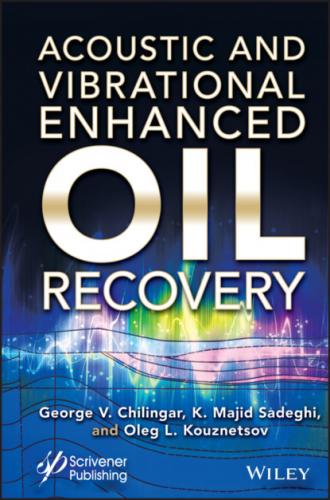At the resonance frequency, irradiated on average the reservoir power is
and this is the reason why the effective absorption of the generator energy which is expended for irradiation through the perforation channels is determined by the density of perforation holes. As Equation (2.38) indicates, this value also defines the generator’s resonance frequency. Considering Equations (2.36) and (2.39), we will evaluate fading factor of the casing wave (caused by the acoustic irradiation through perforation channels) as
Switching to the casing wave fading factor over the well length Hp, one obtains
where δ(E) = Ek/E0 is a relative loss of the generator energy to the irradiation over the well length; here, E0 is kinetic energy on the generator wall. Taking Equations (2.40) and (2.38) into account one obtains an equation connecting n, Hp, and δ(E) values:
(2.41)
Of special interest is the experimental verification of these equations through modeling field conditions. The experimental testing unit was a horizontal model of the reservoir with a well and perforation channels.
The reservoir model had a cylindrical core holder filled up with a cemented porous medium. The core holder, through a steel disk with the perforation hole, was joining a special stand for testing hydraulic vibrators. The space between the steel disk and the porous medium was filled up with a cement stone imitating the well cement shell. The aforementioned special stand imitated a well with hydraulic generator and was represented by a segment of casing with flanges. It was connected with a high-pressure and high performance water-saturated reservoir. Water run-off through the hydraulic generator, a static pressure of the stand and the model was controlled by valves and the pressure was shown on a manometer. The hydraulic generator operating parameters have been determined on a gauge; elastic vibration parameters within the porous medium at the model input and at the model output have been observed using gauges and probes. The gauges have been connected with a normalizer and then the signals have been supplied to the remembering oscillograph and spectrum analyzer. The porous medium has been placed in a core holder that is 0.31-m long and 0.14 m in diameter. The porous medium has been a mixture of quartz sand and has epoxy resin. The perforation channel was 0.003 m in diameter and 0.01-m long. Between the stand and the model has been established a pivot crane intended for switching the model off the stand and measuring background noise and if necessary, for controlling the pressure fluctuations level.
The experimental methodology consisted of measuring fluctuation of vibration parameters at the input, output and within the model at a stable operation of the hydraulic generator. The measurement results have enabled evaluation of the vibration weakening amplitude at different points of the model and at different frequencies. Correlation diagrams of relative pressure fluctuation levels (registered at various points in the model) vs. frequency of the hydraulic generator were obtained. The experimental results have indicated that at transmission of vibrations into the reservoir their weakening occurred increasing with the frequency growth. At the same time, behavior of the curves has been notably different from the anticipated linear correlation of vibrations’ weakening with frequency observed for a saturated porous medium under regular conditions at low frequencies. This unexpected result has been recorded in the maximum deviation area. The recorded pressure fluctuation level in a perforation channel was lower than the relative pressure pulsation level at distant points of the porous model.
The obtained result confirmed the theoretical analysis. The behavior of experimental diagrams may be explained as follows. Within the studied frequency range defined by the parameters of the used experimental equipment the conditions have been determined with optimum conversion of the generator pressure fluctuations into the kinetic energy of liquid within the perforation channel. An elevated efficiency has been observed of the perforation channel monopole irradiation due to an increase of the fluid volumetric flow rate. A relative level of pressure fluctuations in the reservoir has turned out higher than expected; pressure fluctuations in the perforation channel have converted in fluid rate fluctuations. At that, the relative level of pressure fluctuations in the channel has been declining.
In conclusion, an estimate of vibrations’ resonance frequency according to experimental conditions. Parameters used in Equation (2.37) are as follows:
– Cross-section area of a perforation channel, Sk = 7.065 × 10−6 m2;
– The perforation channel length, lk = 0.01 m;
– Fluid density, ρ = 1,000 kg/m3;
– Fluid compressibility β = 0.455 × 10−9 Pa−1.
Substituting these data, one obtains ω = 134 Hz. Comparison of this frequency with the one measured in the experiments are in good agreement. Results obtained indicate a real possibility of increasing efficiency by introducing vibratory energy from a well into the reservoir. The reason is that the real field values of parameters τk and lk in the well with perforation density of 10 to 30 holes/meter result in the excitation of resonance frequencies within a 50- to 300-Hz range.
References and Bibliography
1. Berzam, V.A. Interaction of seismic waves with separation boundaries in porous saturated media. Issues of Nonlinear Geophysics. Collection VNIIYaGG, p. 66–74, Moscow, 1981.
2. Blekhman, I.I. Vibration mechanics. Moscow, Nauka, 400 p., 1994.
3. Blekhman L.I., Kizelwalter B.V. Distribution of flow velocities at the decks of vibration separators for gravity benefication. Ore benefication, 4, p. 53–54, 1981.
4. Valiullin A.V. et al. Some specifics in productive reservoir vibro-treatment technology. Oilfield Engineering, 12, p. 13–16, Moscow, 1973.
5. Gortinsky V.V. et al. Separation Processes at Grain Processing Plants. Moscow, Kolos, 1973, 180 p.
6. Granat N.L. Steady-state vibrations of vessels with two-phase mixture. Izv. AN USSR, Mechanics and Machine-Building, 5, p. 70–75, 1964.
7. Egorov A.G. et al. Consolidation and Acoustic Waves in Saturated Porous Media. Kazan, Kazan University, 1990, 102 p.
8. Isakovich M.A. General acoustics. Moscow, Nauka, 1976, 527 p.
9. Kremer E.V. et al., A
